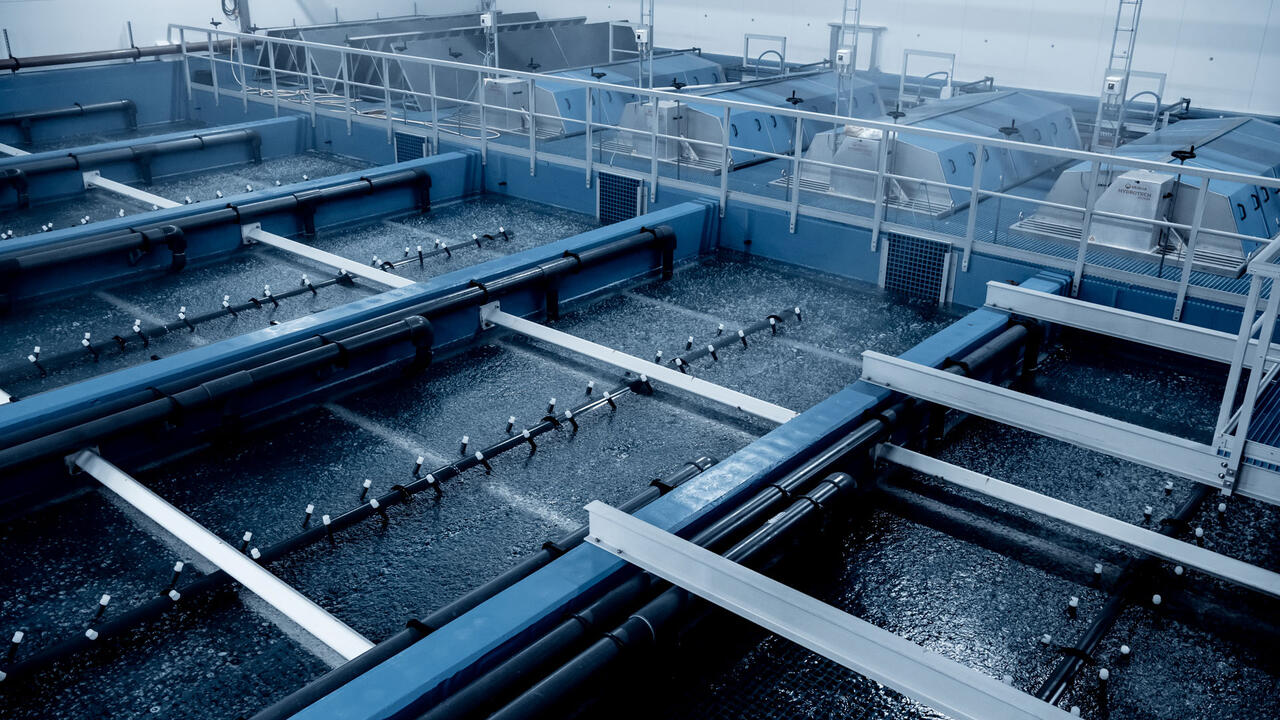
Fish live in direct and constant contact with their environment, the water. Since everything that goes into the fish (feed) also goes out of the fish (urine & feces), the environment needs to be cleaned and treated to keep the fish healthy and happy. This is of high importance for Recirculating Aquaculture Systems (RAS), where one wants to keep the amount of water exchanged as low as possible, either due to limited availability, or to improve operational sustainability.
“As low as possible” is determined by various factors, such as the sensitivity of the fish species in question, or the water treatment efficiency to reduce or remove toxic metabolites, by different types of tiny organisms of microscopic size located inside the biofilters.
Nitrification & Denitrification – what is the difference?
The nitrifying biofilter can be described as the heart of any RAS: In this compartment, microbes convert toxic ammonia into relatively harmless nitrate, a process called nitrification. In AKVA group’s “Zero Water Concept” (ZWC) loop, another set of microbes are found in the denitrifying biofilter. These remove the generated nitrate by converting it into non-toxic nitrogen gas (N2), in a process called denitrification. The involved microbes are taxonomically distinct, and both processes are very different in terms of requirements.
Nitrification requires oxygen, while denitrification requires the lack of oxygen and the presence of nitrate. Nitrifying bacteria grow slowly and require no carbon source apart from CO2. Therefore, they are called autotrophs. In contrast, denitrifying bacteria are fast-growing heterotrophs that need organic carbon to fuel growth.
The combination of nitrification and denitrification is referred to as biological nitrogen removal. This principle has already been used for several decades in the wastewater industry, and different combinations of microbial conversions have led to a variety of strategies and process combinations.
Process control of the biofilter in RAS
In a very simple setting, it is sufficient to monitor the nitrifying process by measuring the concentration of ammonia going in and nitrate going out of the biofilter. Also, for denitrification, where nitrate is removed and released into the atmosphere, the process can be monitored by measuring nitrate depletion. Measuring single parameters is perfectly fine for the purpose of removing nitrogen.
However, the water in RAS does not solely consist of only ammonia and nitrate and the microbes associated with the turnover of these compounds. There is a myriad of other compounds present in the water, and consequently, the microbiota will also be shaped by these compounds. “Everything is everywhere, but the environment selects”, was stated by the Dutch Microbiologist Baas Becking back in 1934 and is still valid today.
It is well-known that a RAS is highly complex to operate due to several processes occurring simultaneously. All these processes must work in tandem to achieve excellent water quality that provides an ideal environment for the fish to grow. Even changing a single parameter slightly, can affect other parameters in various ways. For example, by raising the pH of the water, ammonia can become more toxic, while H2S becomes less toxic for the fish.
Therefore, precision is becoming higher in demand, to keep complete control over the RAS at any time. In this context, precision feeding has already gained attention, as overfeeding has been identified to impact the water quality in RAS negatively. This is because the excess organic carbon in the water will promote the growth of heterotrophic bacteria that can outcompete the slow-growing autotrophs, such as nitrifying bacteria, and/or lead to oxygen depletion in the water column. Furthermore, increased organic loading may redirect the metabolic pathway of the microbes to a process called dissimilatory nitrate reduction to ammonia (DNRA), with ammonia as an end-product, instead of N2.
Data-driven future
Given the challenges outlined above, such as increased heterotrophic growth due to organic loading, it is time to recognize that biofilters in a RAS should be treated with the same precision as any other unit of the RAS. In this effort, AKVA group is currently working on an improved design of the biofilter to simplify the sampling of the water and biofilm. The more we know, the better we can control and modify what is happening inside the biofilter.
For example, a recent study showed that nitrifying bacteria in biofilters of different RAS facilities constituted only up to a maximum of 12 percent of the microbes found on the biofilm carrier. What is the function of the remaining 88 percent? How is the microbial community influenced by the different water quality parameters? Can the microbial community be actively shaped to control the water quality? If yes, what should be the strategy to shape the microbiome? Can we “attract” helpful bacteria to fill out the 88 percent of the microbial community?
To answer these questions, we need to integrate data from the microbiome, water quality, biofilter operational practices, and the resulting fish performance in a holistic approach. Keeping the water quality high in a RAS requires more than rudimentary monitoring of a single parameter to ensure functionality. There has been a tremendous advancement in knowledge and measurement techniques over the past 20 years, both for chemical analyses, for microbial analyses, and data integration. Therefore, it is important to also use the available methods and exploit the data to optimize the biofilter performance and overall microbiota in the RAS.
Currently, the only commercially available water quality monitoring systems for RAS rely on chemical water quality parameters, but it does not consider the microbial water quality in any way. Since microbes drive the actual water treatment, their dynamics and interactions need to be understood and included in tomorrow’s water quality model. In this context, AKVA group is also improving and optimizing protocols for backwashing the biofilters to control activity loss and avoid off-flavor issues. Optimizing a biofilter includes design, as well as operation.
By actively controlling and shaping the microbial community, the nitrifying biofilter could become much more than just a component to remove toxic ammonia and particles from the water. The heart and perhaps even the brain of a RAS.
About the author:
Dr. Ingrid Henry
Biotechnology Specialist
RAS R&D in AKVA group
